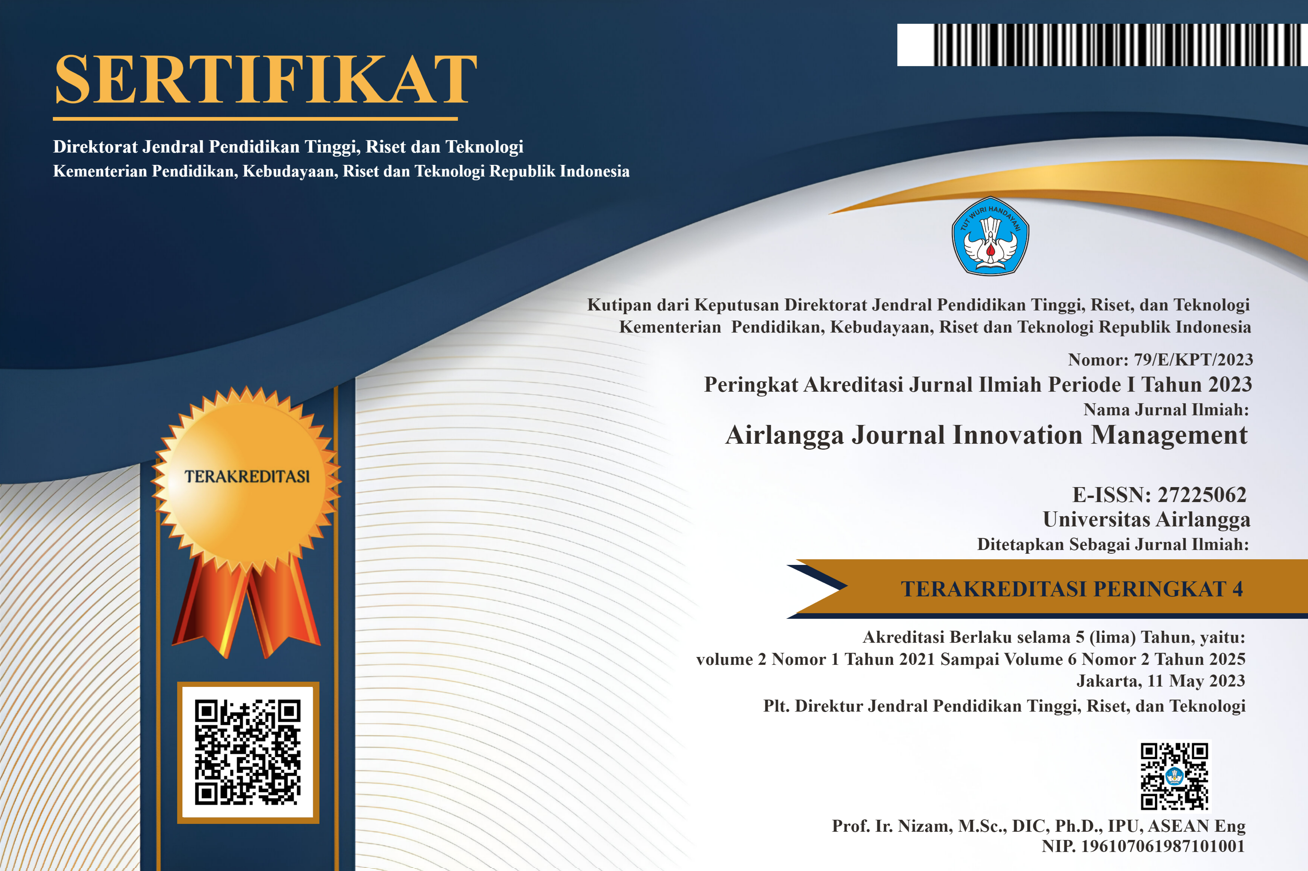ENTREPRENEURSHIP SELF-EFFICACY, ATTITUDES TOWARDS ENTREPRENEURSHIP, AND STUDENT'S ENTREPRENEURSHIP INTEREST
Downloads
One of the causes of large number unemployement is an imbalance between number of jobs and number of job applicants. Total population of Indonesia in September 2020 has reached 270 million (BPS, 2021). The Central Statistics noted that there are quite a large number of unemployed college graduates (BPS, 2020). Increasing number of entrepreneurs is considered to be one of solutions to reduce unemployment. This study aims to determine an effect of entrepreneurial self-efficacy on entrepreneurial intention directly or through attitudes towards entrepreneurship. This research was conducted at a private university in Yogyakarta with Informatics Engineering student respondents. Research data processing was carried out by Partial Least Square 3 software. The results of this study indicate that entrepreneurial self-efficacy has a direct and positive effect on entrepreneurial intention. Then, attitudes towards entrepreneurship have been shown to play a role as a mediator in relationship between entrepreneurial self-efficacy and entrepreneurial intention. Based on these results, mediating role of attitudes towards entrepreneurship is partial mediation. The results of this study are expected to be useful to encourage higher education institutions and government to motivate younger generation, especially Informatics Engineering students, to have an entrepreneurial spirit and have a positive attitude towards entrepreneurial behavior so that they are interested in becoming entrepreneurs. Informatics Engineering students are expected to be able to support economic recovery due to Covid-19 pandemic through works in form of software.
Ajzen, I. (1991). The theory of planned behavior. Organizational Behavior and Human Decision Processes, 50(2), 179–211. https://doi.org/10.1016/0749-5978(91)90020-T
Badan Pusat Statistik (BPS). (2020). Pengangguran terbuka menurut pendidikan tertinggi yang ditamatkan. Https://Www.Bps.Go.Id/Link Tabel Statis/View/Id/972. https://www.bps.go.id/statictable/2009/04/16/972/pengangguran-terbuka-menurut-pendidikan-tertinggi-yang-ditamatkan-1986---2020
Badan Pusat Statistik (BPS). (2021). Hasil Sensus Penduduk 2020. https://www.bps.go.id/pressrelease/2021/01/21/1854/hasil-sensus-penduduk-2020.html
Bandura, A. (1977). Self-efficacy: toward a unifying theory of behavioral change. Psychological Review, 87(2), 191–215.
Bandura, A. (1997). Self-Efficacy: The Exercise of Control. W. H. Freeman and Company.
BarNir, A., Watson, W. E., & Hutchins, H. M. (2011). Mediation and Moderated Mediation in the Relationship Among Role Models, Self-Efficacy, Entrepreneurial Career Intention, and Gender. Journal of Applied Social Psychology, 41(2), 270–297. https://doi.org/10.1111/j.1559-1816.2010.00713.x
Baron, R. M., Kenny, D. A. (1986). Moderator-Mediator Variables Distinction in Social Psychological Research: Conceptual, Strategic, and Statistical Considerations. Journal of Personality and Social Psychology, 51(6), 1173–1182.
De Noble, A. F., Jung, D., Ehrlich, S. B. (1999). Entrepreneurial self-efficacy: The development of a measure and its relation to entrepreneurial action (R. et Al. (ed.)). Babson College.
Fayolle, A., & Liñán, F. (2014). The future of research on entrepreneurial intentions. Journal of Business Research, 67(5), 663–666. https://doi.org/10.1016/j.jbusres.2013.11.024
Guerrero, M., Rialp, J., & Urbano, D. (2008). The impact of desirability and feasibility on entrepreneurial intentions: A structural equation model. International Entrepreneurship and Management Journal, 4(1), 35–50. https://doi.org/10.1007/s11365-006-0032-x
Hair, J. F., Sarstedt, M., Hopkins, L., & Kuppelwieser, V. G. (2014). Partial least squares structural equation modeling (PLS-SEM): An emerging tool in business research. European Business Review, 26(2), 106–121. https://doi.org/10.1108/EBR-10-2013-0128
Henseler, J., Ringle, C. M., & Sinkovics, R. R. (2009). The use of partial least squares path modeling in international marketing. Advances in International Marketing, 20(May 2014), 277–319. https://doi.org/10.1108/S1474-7979(2009)0000020014
Kautonen, T., van Gelderen, M., & Tornikoski, E. T. (2013). Predicting entrepreneurial behaviour: A test of the theory of planned behaviour. Applied Economics, 45(6), 697–707. https://doi.org/10.1080/00036846.2011.610750
KOMINFO. (2020). Pulihkan Ekonomi Nasional, Tumbuhkan Jiwa Kewirausahaan pada Generasi Muda. https://www.kominfo.go.id/content/detail/30271/pulihkan-ekonomi-nasional-tumbuhkan-jiwa-kewirausahaan-pada-generasi-muda/0/berita
Liñán, F., Chen, Y. W. (2009). Development and Cross-Cultural Application of a Speciï¬c Instrument to Measure Entrepreneurial Intentions. Entrepreneurship Theory and Practice, 33(3), 593–617.
Liñán, F. (2008). Skill and value perceptions: How do they affect entrepreneurial intentions? International Entrepreneurship and Management Journal, 4(3), 257–272. https://doi.org/10.1007/s11365-008-0093-0
Liñán, F., Rodríguez-Cohard, J. C., & Rueda-Cantuche, J. M. (2011). Factors affecting entrepreneurial intention levels: A role for education. International Entrepreneurship and Management Journal, 7(2), 195–218. https://doi.org/10.1007/s11365-010-0154-z
Palamida, E. (2016). Determinants of entrepreneurial intentions: The interrelated role of background, situational and psychological factors. Doctoral Dissertation, May. https://theses.ncl.ac.uk/dspace/bitstream/10443/3299/1/Palamida%2C E 2016.pdf%0Ahttp://libproxy.library.wmich.edu/login?url=https://search.proquest.com/docview/1913433098?accountid=15099%0Ahttp://primo-pmtna01.hosted.exlibrisgroup.com/openurl/01WMU/01WMU_
Parvaneh Gelard. (2011). Impact of some contextual factors on entrepreneurial intention of university students. African Journal of Business Management, 5(26), 10707–10717. https://doi.org/10.5897/ajbm10.891
Rosique-Blasco, M., Madrid-Guijarro, A., & García-Pérez-de-Lema, D. (2018). The effects of personal abilities and self-efficacy on entrepreneurial intentions. International Entrepreneurship and Management Journal, 14(4), 1025–1052. https://doi.org/10.1007/s11365-017-0469-0
Sánchez, J. C. (2011). University training for entrepreneurial competencies: Its impact on intention of venture creation. International Entrepreneurship and Management Journal, 7, 239–254.
Shahab, Y., Chengang, Y., Arbizu, A. D., & Haider, M. J. (2019). Entrepreneurial self-efficacy and intention: do entrepreneurial creativity and education matter? International Journal of Entrepreneurial Behaviour and Research, 25(2), 259–280. https://doi.org/10.1108/IJEBR-12-2017-0522
Souitaris, V., Zerbinati, S., & Al-Laham, A. (2007). Do entrepreneurship programmes raise entrepreneurial intention of science and engineering students? The effect of learning, inspiration and resources. Journal of Business Venturing, 22(4), 566–591. https://doi.org/10.1016/j.jbusvent.2006.05.002
Sugiyono. (2017). Metode Penelitian Kuantitatif, Kualitatif dan R&D. Alfabeta.
Thompson, E. R. (2009). Entrepreneurial Intent : and Development Reliable Metric. Entrepreneurship: Theory and Practice, 33(0), 669–695. http://papers.ssrn.com/sol3/papers.cfm?abstract_id=1396451
Trevelyan, R. (2009). Entrepreneurial Attitudes and Action in New Venture Development. The International Journal of Entrepreneurship and Innovation, 10(1), 21–32. https://doi.org/https://doi.org/10.5367/000000009787414271
Tsai, K. H., Chang, H. C., & Peng, C. Y. (2016). Refining the linkage between perceived capability and entrepreneurial intention: roles of perceived opportunity, fear of failure, and gender. International Entrepreneurship and Management Journal, 12(4), 1127–1145. https://doi.org/10.1007/s11365-016-0383-x
Wilson, F., Kickul, J. R., Marlino, D. (2007). Gender, entrepreneurial self-efficacy, and entrepreneurial career intentions: implications for entrepreneurship education. Entrepreneurship: Theory and Practice, 31(3), 387–406.
- The journal allows authors to hold copyright without restrictions and retain publication rights without restrictions. The author retains the copyright and grants the first publication rights to the journal, with his work simultaneously licensed under the Creative Commons Attribution-NonCommercial-ShareAlike 4.0 International License (CC BY-NC-SA). This license allows others to share the work with acknowledgment of authorship and initial publication in this journal, provided that the work is not used for commercial purposes and that any derivative works must use the same license.
- Authors may enter into additional contractual agreements for non-exclusive distribution of the journal publication version (e.g., uploading it to an institutional repository or publishing it in book form), while still including acknowledgment of the initial publication in this journal.
- Authors are allowed and encouraged to upload their work online (e.g., in an institutional repository or personal website) before and during the submission process. This can support productive scientific exchanges as well as increase citations to published works.

AJIM by UNAIR is licensed under a Creative Commons Attribution-NonCommercial-ShareAlike 4.0 International License.





















